Impact of HRM Practices on Employee Performance
VerifiedAdded on 2020/05/28
|8
|2067
|102
AI Summary
This assignment delves into the profound impact of high-performance human resource management (HRM) practices on employees' attitudes, behaviors, and overall performance. It examines how various HRM practices, such as recruitment, training, and compensation, contribute to a positive work environment and enhance employee engagement. The analysis draws upon extensive research studies and academic publications to provide a comprehensive understanding of the relationship between HRM practices and organizational success.
Contribute Materials
Your contribution can guide someone’s learning journey. Share your
documents today.
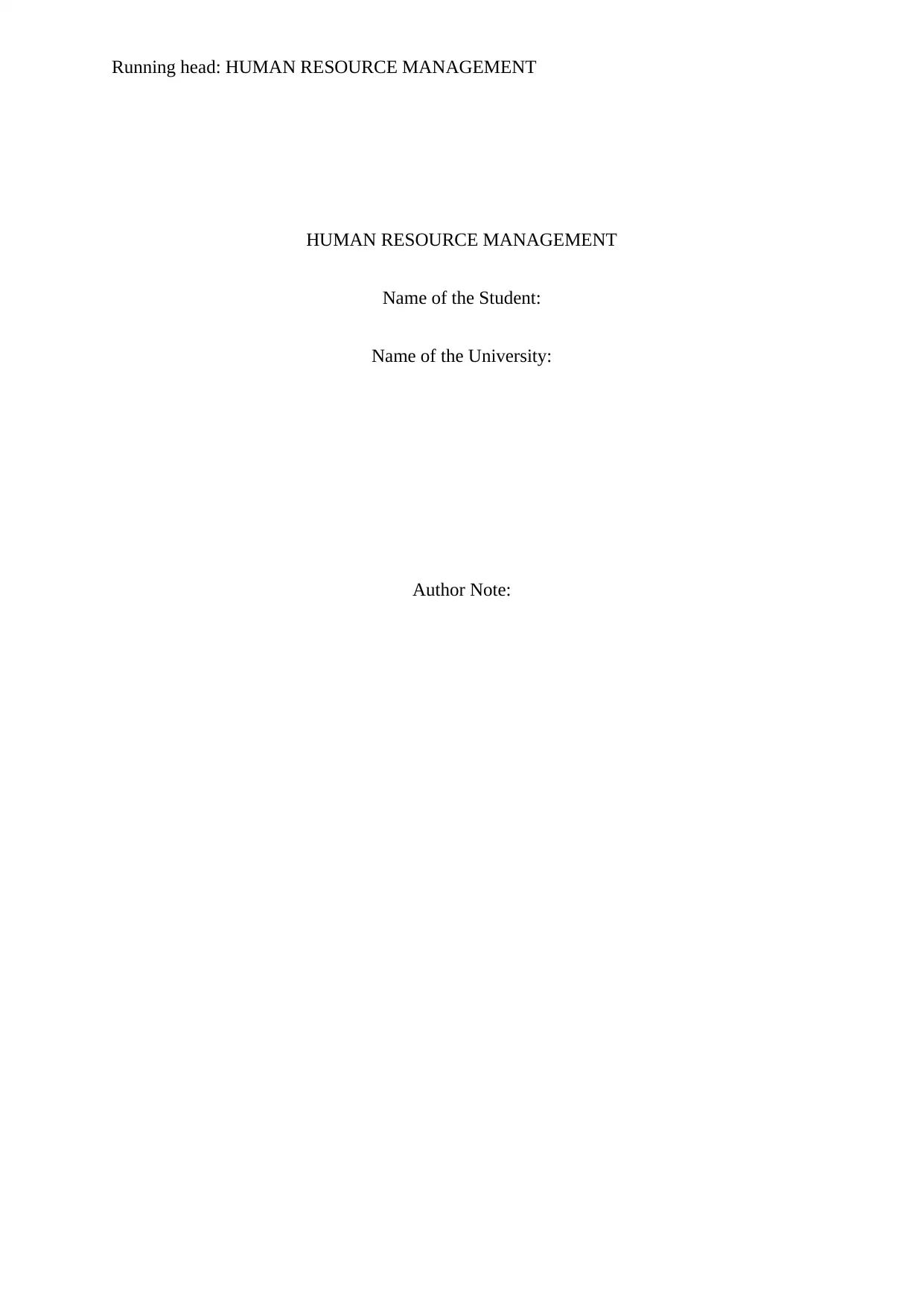
Running head: HUMAN RESOURCE MANAGEMENT
HUMAN RESOURCE MANAGEMENT
Name of the Student:
Name of the University:
Author Note:
HUMAN RESOURCE MANAGEMENT
Name of the Student:
Name of the University:
Author Note:
Secure Best Marks with AI Grader
Need help grading? Try our AI Grader for instant feedback on your assignments.
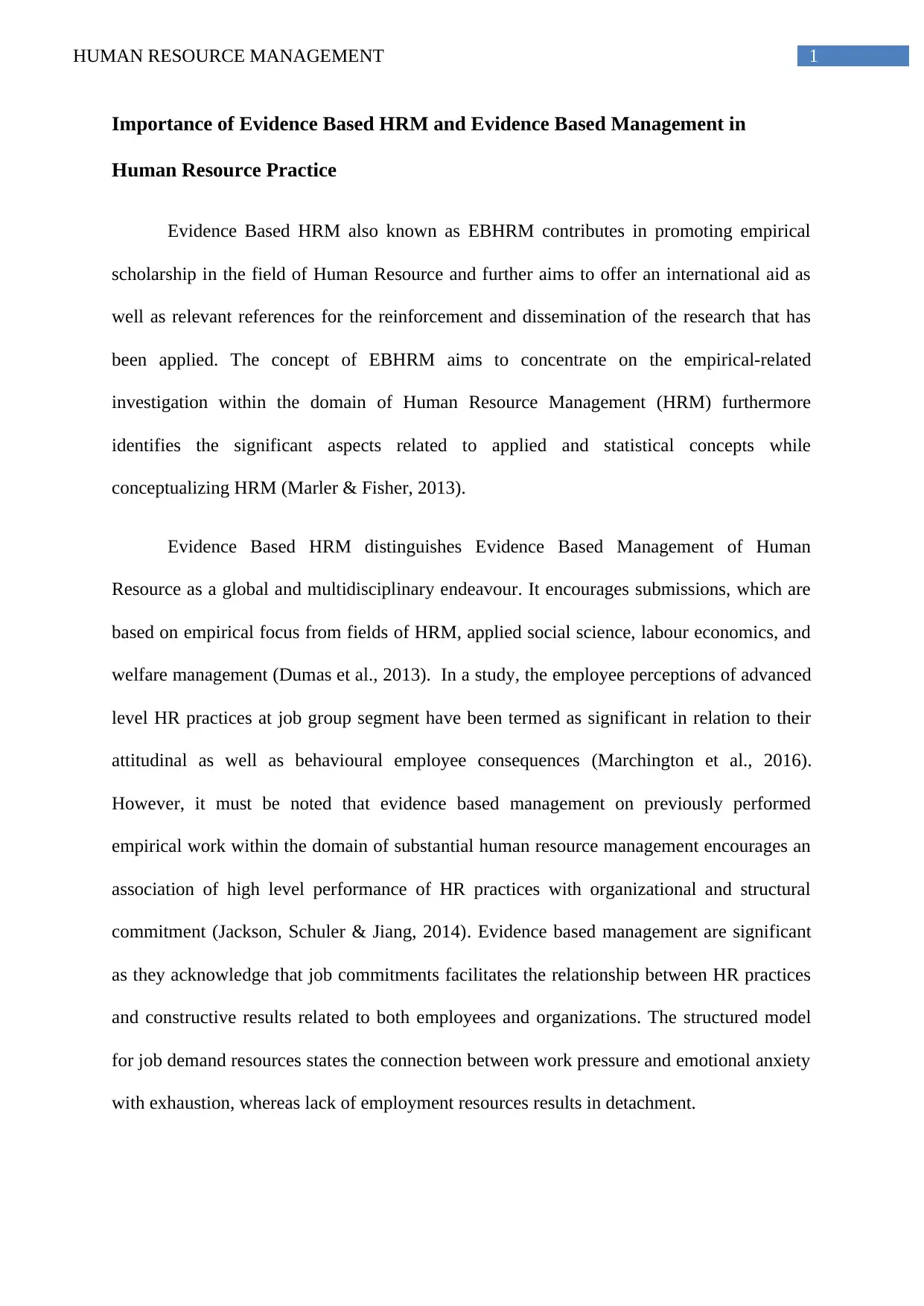
1HUMAN RESOURCE MANAGEMENT
Importance of Evidence Based HRM and Evidence Based Management in
Human Resource Practice
Evidence Based HRM also known as EBHRM contributes in promoting empirical
scholarship in the field of Human Resource and further aims to offer an international aid as
well as relevant references for the reinforcement and dissemination of the research that has
been applied. The concept of EBHRM aims to concentrate on the empirical-related
investigation within the domain of Human Resource Management (HRM) furthermore
identifies the significant aspects related to applied and statistical concepts while
conceptualizing HRM (Marler & Fisher, 2013).
Evidence Based HRM distinguishes Evidence Based Management of Human
Resource as a global and multidisciplinary endeavour. It encourages submissions, which are
based on empirical focus from fields of HRM, applied social science, labour economics, and
welfare management (Dumas et al., 2013). In a study, the employee perceptions of advanced
level HR practices at job group segment have been termed as significant in relation to their
attitudinal as well as behavioural employee consequences (Marchington et al., 2016).
However, it must be noted that evidence based management on previously performed
empirical work within the domain of substantial human resource management encourages an
association of high level performance of HR practices with organizational and structural
commitment (Jackson, Schuler & Jiang, 2014). Evidence based management are significant
as they acknowledge that job commitments facilitates the relationship between HR practices
and constructive results related to both employees and organizations. The structured model
for job demand resources states the connection between work pressure and emotional anxiety
with exhaustion, whereas lack of employment resources results in detachment.
Importance of Evidence Based HRM and Evidence Based Management in
Human Resource Practice
Evidence Based HRM also known as EBHRM contributes in promoting empirical
scholarship in the field of Human Resource and further aims to offer an international aid as
well as relevant references for the reinforcement and dissemination of the research that has
been applied. The concept of EBHRM aims to concentrate on the empirical-related
investigation within the domain of Human Resource Management (HRM) furthermore
identifies the significant aspects related to applied and statistical concepts while
conceptualizing HRM (Marler & Fisher, 2013).
Evidence Based HRM distinguishes Evidence Based Management of Human
Resource as a global and multidisciplinary endeavour. It encourages submissions, which are
based on empirical focus from fields of HRM, applied social science, labour economics, and
welfare management (Dumas et al., 2013). In a study, the employee perceptions of advanced
level HR practices at job group segment have been termed as significant in relation to their
attitudinal as well as behavioural employee consequences (Marchington et al., 2016).
However, it must be noted that evidence based management on previously performed
empirical work within the domain of substantial human resource management encourages an
association of high level performance of HR practices with organizational and structural
commitment (Jackson, Schuler & Jiang, 2014). Evidence based management are significant
as they acknowledge that job commitments facilitates the relationship between HR practices
and constructive results related to both employees and organizations. The structured model
for job demand resources states the connection between work pressure and emotional anxiety
with exhaustion, whereas lack of employment resources results in detachment.

2HUMAN RESOURCE MANAGEMENT
HR strategies to be implemented by Israel Tobin to demonstrate his strategic
value to CERA
HR managers are generally expected to control and improve the business performance
with the concept of Strategic Human Resource Management (SHRM). The idea of SHRM is
to form a linkage between human resource practices and the strategic to establish
organizational culture, in nurturing proficiency, elasticity as well as competitive benefits
(Gully et al., 2013). The following HR strategies will assist Israel Tobin, the HR manager of
Civil Engineering & Research Associated (CERA) to demonstrate to the CEO, Mark French
the strategic value he will provide to the company. Israel Tobin, being aware of the CEO’s
task focused behavioural nature must present strategies, which would reflect effective
outcomes to enhance the company’s growth.
One of the major roles of the HR should be to align its strategies with wider business
structure and further illustrate methods in which an organization can drive better
productivity and revenue (Sparrow, Brewster & Chung, 2016). The concept of Human
Capital management must be taken into consideration here, which encourages the HR
manager to shape their objectives and make delivering outcomes their primary focal
point.
With the implementation of Human Capital Management approach, organizations
offers more strategic processes for executives, retain employee engagement as well as
efficiency (Hollenbeck & Jamieson, 2015). The automation and standardization
process will support the HR department to ascertain reliability and efficient alignment
(Ulrich & Dulebohn, 2015). The process of standardization helps in cost and time
HR strategies to be implemented by Israel Tobin to demonstrate his strategic
value to CERA
HR managers are generally expected to control and improve the business performance
with the concept of Strategic Human Resource Management (SHRM). The idea of SHRM is
to form a linkage between human resource practices and the strategic to establish
organizational culture, in nurturing proficiency, elasticity as well as competitive benefits
(Gully et al., 2013). The following HR strategies will assist Israel Tobin, the HR manager of
Civil Engineering & Research Associated (CERA) to demonstrate to the CEO, Mark French
the strategic value he will provide to the company. Israel Tobin, being aware of the CEO’s
task focused behavioural nature must present strategies, which would reflect effective
outcomes to enhance the company’s growth.
One of the major roles of the HR should be to align its strategies with wider business
structure and further illustrate methods in which an organization can drive better
productivity and revenue (Sparrow, Brewster & Chung, 2016). The concept of Human
Capital management must be taken into consideration here, which encourages the HR
manager to shape their objectives and make delivering outcomes their primary focal
point.
With the implementation of Human Capital Management approach, organizations
offers more strategic processes for executives, retain employee engagement as well as
efficiency (Hollenbeck & Jamieson, 2015). The automation and standardization
process will support the HR department to ascertain reliability and efficient alignment
(Ulrich & Dulebohn, 2015). The process of standardization helps in cost and time
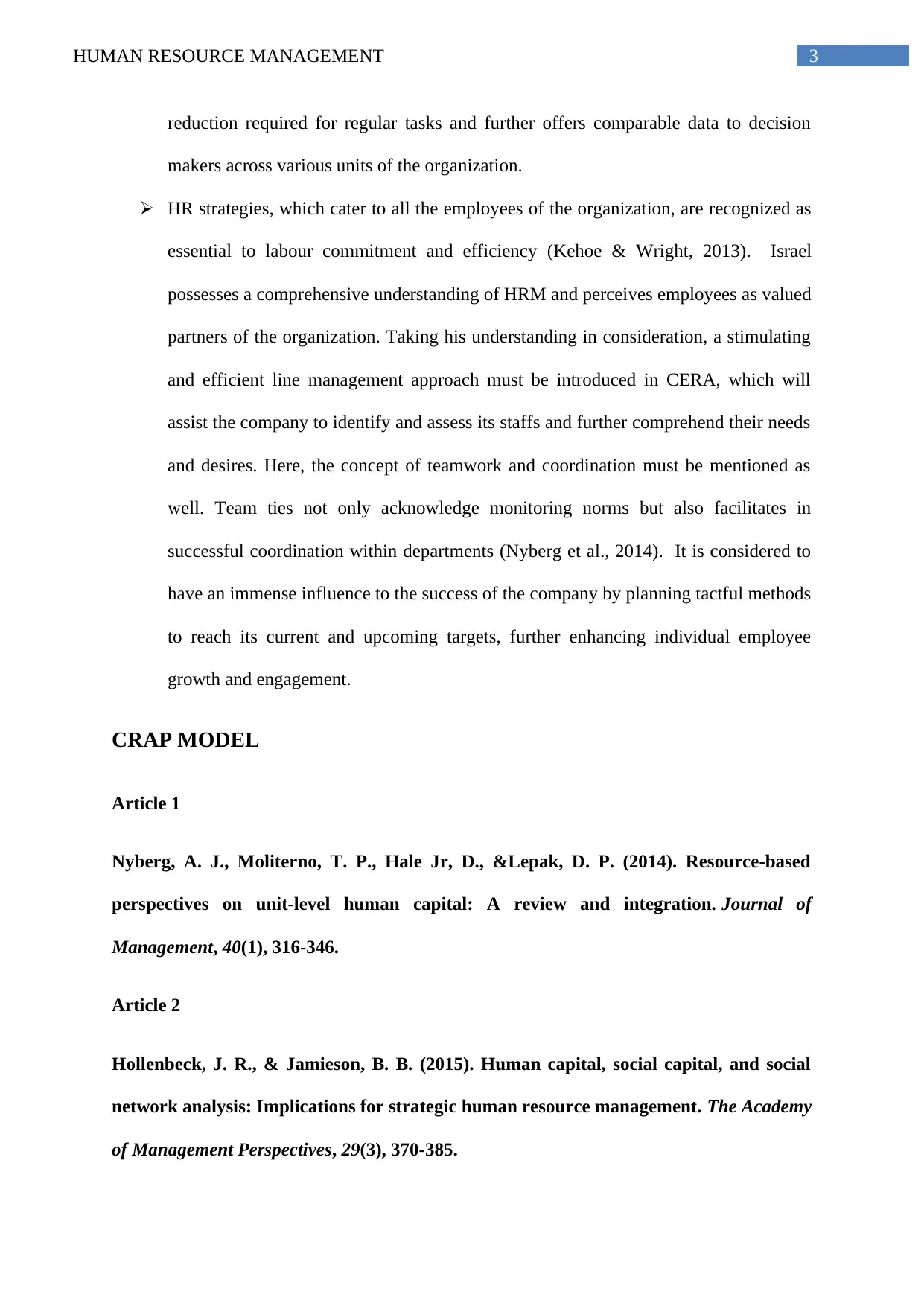
3HUMAN RESOURCE MANAGEMENT
reduction required for regular tasks and further offers comparable data to decision
makers across various units of the organization.
HR strategies, which cater to all the employees of the organization, are recognized as
essential to labour commitment and efficiency (Kehoe & Wright, 2013). Israel
possesses a comprehensive understanding of HRM and perceives employees as valued
partners of the organization. Taking his understanding in consideration, a stimulating
and efficient line management approach must be introduced in CERA, which will
assist the company to identify and assess its staffs and further comprehend their needs
and desires. Here, the concept of teamwork and coordination must be mentioned as
well. Team ties not only acknowledge monitoring norms but also facilitates in
successful coordination within departments (Nyberg et al., 2014). It is considered to
have an immense influence to the success of the company by planning tactful methods
to reach its current and upcoming targets, further enhancing individual employee
growth and engagement.
CRAP MODEL
Article 1
Nyberg, A. J., Moliterno, T. P., Hale Jr, D., &Lepak, D. P. (2014). Resource-based
perspectives on unit-level human capital: A review and integration. Journal of
Management, 40(1), 316-346.
Article 2
Hollenbeck, J. R., & Jamieson, B. B. (2015). Human capital, social capital, and social
network analysis: Implications for strategic human resource management. The Academy
of Management Perspectives, 29(3), 370-385.
reduction required for regular tasks and further offers comparable data to decision
makers across various units of the organization.
HR strategies, which cater to all the employees of the organization, are recognized as
essential to labour commitment and efficiency (Kehoe & Wright, 2013). Israel
possesses a comprehensive understanding of HRM and perceives employees as valued
partners of the organization. Taking his understanding in consideration, a stimulating
and efficient line management approach must be introduced in CERA, which will
assist the company to identify and assess its staffs and further comprehend their needs
and desires. Here, the concept of teamwork and coordination must be mentioned as
well. Team ties not only acknowledge monitoring norms but also facilitates in
successful coordination within departments (Nyberg et al., 2014). It is considered to
have an immense influence to the success of the company by planning tactful methods
to reach its current and upcoming targets, further enhancing individual employee
growth and engagement.
CRAP MODEL
Article 1
Nyberg, A. J., Moliterno, T. P., Hale Jr, D., &Lepak, D. P. (2014). Resource-based
perspectives on unit-level human capital: A review and integration. Journal of
Management, 40(1), 316-346.
Article 2
Hollenbeck, J. R., & Jamieson, B. B. (2015). Human capital, social capital, and social
network analysis: Implications for strategic human resource management. The Academy
of Management Perspectives, 29(3), 370-385.
Secure Best Marks with AI Grader
Need help grading? Try our AI Grader for instant feedback on your assignments.
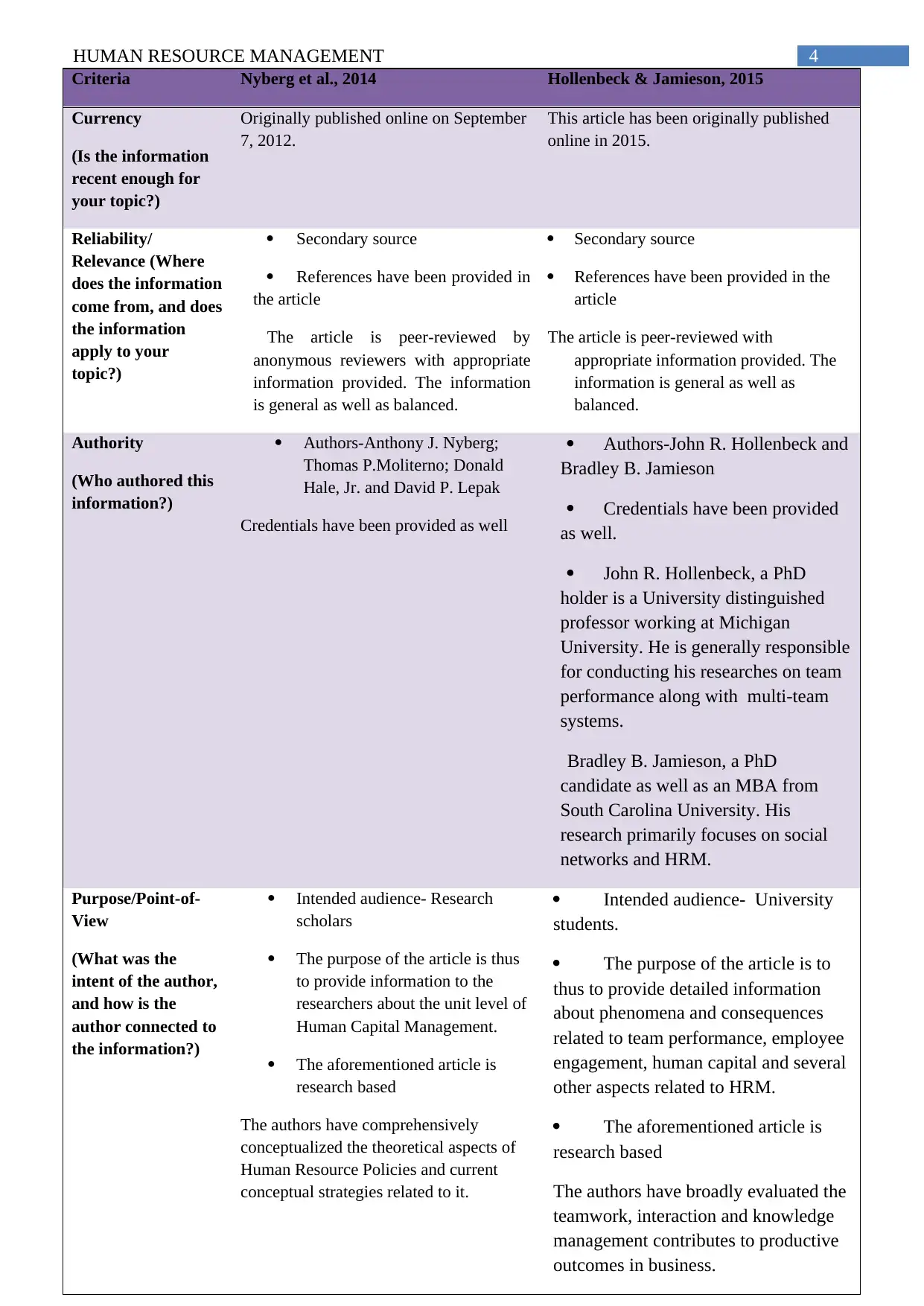
4HUMAN RESOURCE MANAGEMENT
Criteria Nyberg et al., 2014 Hollenbeck & Jamieson, 2015
Currency
(Is the information
recent enough for
your topic?)
Originally published online on September
7, 2012.
This article has been originally published
online in 2015.
Reliability/
Relevance (Where
does the information
come from, and does
the information
apply to your
topic?)
Secondary source
References have been provided in
the article
The article is peer-reviewed by
anonymous reviewers with appropriate
information provided. The information
is general as well as balanced.
Secondary source
References have been provided in the
article
The article is peer-reviewed with
appropriate information provided. The
information is general as well as
balanced.
Authority
(Who authored this
information?)
Authors-Anthony J. Nyberg;
Thomas P.Moliterno; Donald
Hale, Jr. and David P. Lepak
Credentials have been provided as well
Authors-John R. Hollenbeck and
Bradley B. Jamieson
Credentials have been provided
as well.
John R. Hollenbeck, a PhD
holder is a University distinguished
professor working at Michigan
University. He is generally responsible
for conducting his researches on team
performance along with multi-team
systems.
Bradley B. Jamieson, a PhD
candidate as well as an MBA from
South Carolina University. His
research primarily focuses on social
networks and HRM.
Purpose/Point-of-
View
(What was the
intent of the author,
and how is the
author connected to
the information?)
Intended audience- Research
scholars
The purpose of the article is thus
to provide information to the
researchers about the unit level of
Human Capital Management.
The aforementioned article is
research based
The authors have comprehensively
conceptualized the theoretical aspects of
Human Resource Policies and current
conceptual strategies related to it.
Intended audience- University
students.
The purpose of the article is to
thus to provide detailed information
about phenomena and consequences
related to team performance, employee
engagement, human capital and several
other aspects related to HRM.
The aforementioned article is
research based
The authors have broadly evaluated the
teamwork, interaction and knowledge
management contributes to productive
outcomes in business.
Criteria Nyberg et al., 2014 Hollenbeck & Jamieson, 2015
Currency
(Is the information
recent enough for
your topic?)
Originally published online on September
7, 2012.
This article has been originally published
online in 2015.
Reliability/
Relevance (Where
does the information
come from, and does
the information
apply to your
topic?)
Secondary source
References have been provided in
the article
The article is peer-reviewed by
anonymous reviewers with appropriate
information provided. The information
is general as well as balanced.
Secondary source
References have been provided in the
article
The article is peer-reviewed with
appropriate information provided. The
information is general as well as
balanced.
Authority
(Who authored this
information?)
Authors-Anthony J. Nyberg;
Thomas P.Moliterno; Donald
Hale, Jr. and David P. Lepak
Credentials have been provided as well
Authors-John R. Hollenbeck and
Bradley B. Jamieson
Credentials have been provided
as well.
John R. Hollenbeck, a PhD
holder is a University distinguished
professor working at Michigan
University. He is generally responsible
for conducting his researches on team
performance along with multi-team
systems.
Bradley B. Jamieson, a PhD
candidate as well as an MBA from
South Carolina University. His
research primarily focuses on social
networks and HRM.
Purpose/Point-of-
View
(What was the
intent of the author,
and how is the
author connected to
the information?)
Intended audience- Research
scholars
The purpose of the article is thus
to provide information to the
researchers about the unit level of
Human Capital Management.
The aforementioned article is
research based
The authors have comprehensively
conceptualized the theoretical aspects of
Human Resource Policies and current
conceptual strategies related to it.
Intended audience- University
students.
The purpose of the article is to
thus to provide detailed information
about phenomena and consequences
related to team performance, employee
engagement, human capital and several
other aspects related to HRM.
The aforementioned article is
research based
The authors have broadly evaluated the
teamwork, interaction and knowledge
management contributes to productive
outcomes in business.

5HUMAN RESOURCE MANAGEMENT
The CRAP test primarily explores four major areas namely currency, reliability, authority
and purpose. The above CRAP model it can be witnessed that the two internet sources have
successfully cleared the four fundamental principles of the CRAP test. Thus, it can be stated
that the two selected articles have effectively accomplished the criteria of the CRAP test.
Conclusion
Therefore, from the above discussion it can be concluded that Evidence Based Human
Resource practice can be regarded as an essential tool for the establishment and maintenance
of the reliability and sincerity of the HR function performed at the strategic level effective
within the organization. One of the importance of evidence based HR practice lies in
increasing the ability to support HR practice with the strategic purposes of the company. It
further provides a detailed analytical approach on the present data, statistics and analytics
prevailing within the organization. However, it must be noted that a HR who relies on
evidence-based management generally holds a different approach to risks, issues and rewards
of management. As per the evaluation, it can be stated that, the three aforementioned strategic
approaches would provide direction to Israel Tobin to demonstrate an outstanding
presentation to Mark French about the ways he could add a strategic value further resulting to
productive and cost-effective outcomes to CERA. The two internet resources from where the
strategic human resource strategies are drawn have been methodically evaluated with the help
of CRAP model in order to assess the credibility of the two aforementioned articles.
The CRAP test primarily explores four major areas namely currency, reliability, authority
and purpose. The above CRAP model it can be witnessed that the two internet sources have
successfully cleared the four fundamental principles of the CRAP test. Thus, it can be stated
that the two selected articles have effectively accomplished the criteria of the CRAP test.
Conclusion
Therefore, from the above discussion it can be concluded that Evidence Based Human
Resource practice can be regarded as an essential tool for the establishment and maintenance
of the reliability and sincerity of the HR function performed at the strategic level effective
within the organization. One of the importance of evidence based HR practice lies in
increasing the ability to support HR practice with the strategic purposes of the company. It
further provides a detailed analytical approach on the present data, statistics and analytics
prevailing within the organization. However, it must be noted that a HR who relies on
evidence-based management generally holds a different approach to risks, issues and rewards
of management. As per the evaluation, it can be stated that, the three aforementioned strategic
approaches would provide direction to Israel Tobin to demonstrate an outstanding
presentation to Mark French about the ways he could add a strategic value further resulting to
productive and cost-effective outcomes to CERA. The two internet resources from where the
strategic human resource strategies are drawn have been methodically evaluated with the help
of CRAP model in order to assess the credibility of the two aforementioned articles.
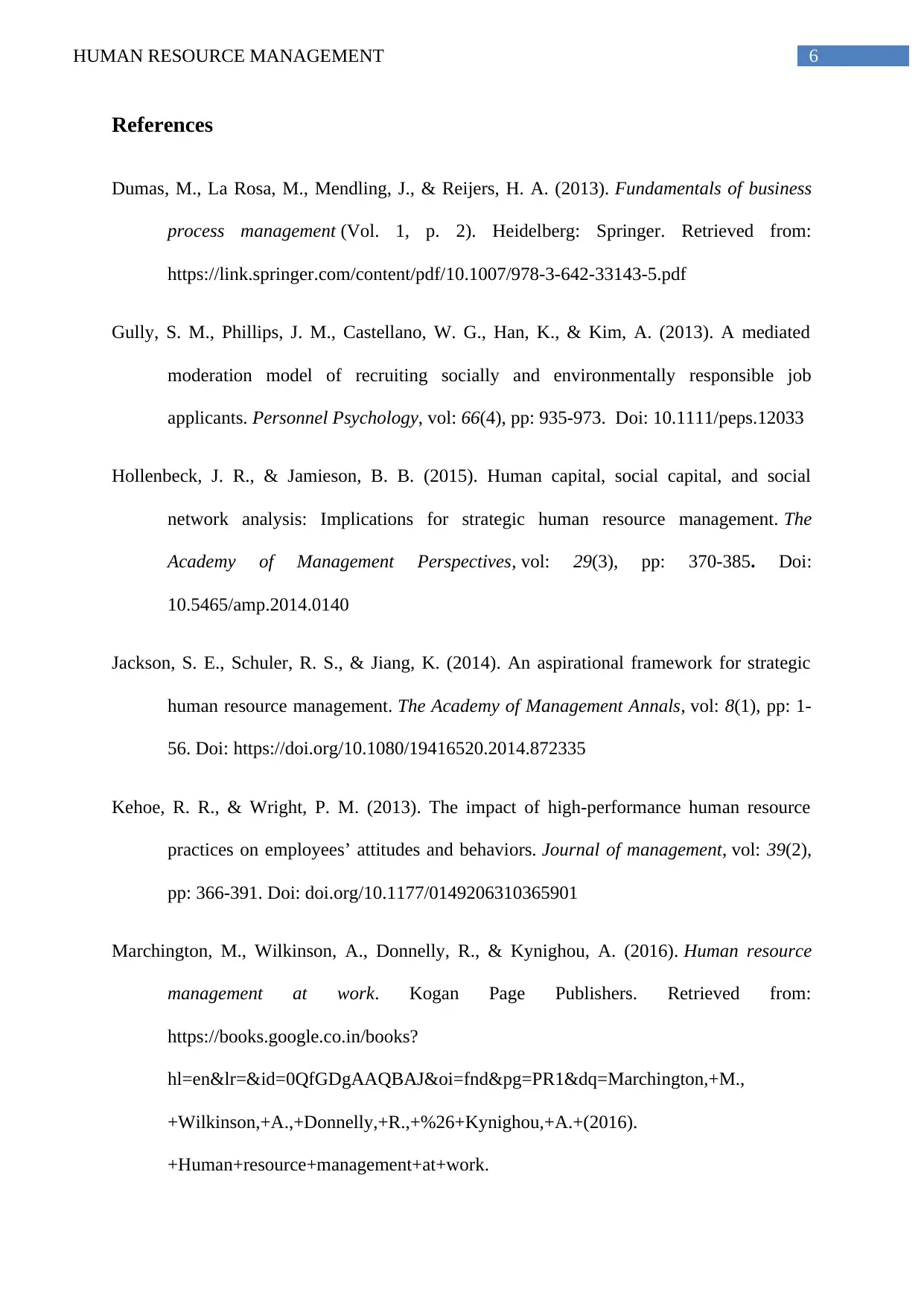
6HUMAN RESOURCE MANAGEMENT
References
Dumas, M., La Rosa, M., Mendling, J., & Reijers, H. A. (2013). Fundamentals of business
process management (Vol. 1, p. 2). Heidelberg: Springer. Retrieved from:
https://link.springer.com/content/pdf/10.1007/978-3-642-33143-5.pdf
Gully, S. M., Phillips, J. M., Castellano, W. G., Han, K., & Kim, A. (2013). A mediated
moderation model of recruiting socially and environmentally responsible job
applicants. Personnel Psychology, vol: 66(4), pp: 935-973. Doi: 10.1111/peps.12033
Hollenbeck, J. R., & Jamieson, B. B. (2015). Human capital, social capital, and social
network analysis: Implications for strategic human resource management. The
Academy of Management Perspectives, vol: 29(3), pp: 370-385. Doi:
10.5465/amp.2014.0140
Jackson, S. E., Schuler, R. S., & Jiang, K. (2014). An aspirational framework for strategic
human resource management. The Academy of Management Annals, vol: 8(1), pp: 1-
56. Doi: https://doi.org/10.1080/19416520.2014.872335
Kehoe, R. R., & Wright, P. M. (2013). The impact of high-performance human resource
practices on employees’ attitudes and behaviors. Journal of management, vol: 39(2),
pp: 366-391. Doi: doi.org/10.1177/0149206310365901
Marchington, M., Wilkinson, A., Donnelly, R., & Kynighou, A. (2016). Human resource
management at work. Kogan Page Publishers. Retrieved from:
https://books.google.co.in/books?
hl=en&lr=&id=0QfGDgAAQBAJ&oi=fnd&pg=PR1&dq=Marchington,+M.,
+Wilkinson,+A.,+Donnelly,+R.,+%26+Kynighou,+A.+(2016).
+Human+resource+management+at+work.
References
Dumas, M., La Rosa, M., Mendling, J., & Reijers, H. A. (2013). Fundamentals of business
process management (Vol. 1, p. 2). Heidelberg: Springer. Retrieved from:
https://link.springer.com/content/pdf/10.1007/978-3-642-33143-5.pdf
Gully, S. M., Phillips, J. M., Castellano, W. G., Han, K., & Kim, A. (2013). A mediated
moderation model of recruiting socially and environmentally responsible job
applicants. Personnel Psychology, vol: 66(4), pp: 935-973. Doi: 10.1111/peps.12033
Hollenbeck, J. R., & Jamieson, B. B. (2015). Human capital, social capital, and social
network analysis: Implications for strategic human resource management. The
Academy of Management Perspectives, vol: 29(3), pp: 370-385. Doi:
10.5465/amp.2014.0140
Jackson, S. E., Schuler, R. S., & Jiang, K. (2014). An aspirational framework for strategic
human resource management. The Academy of Management Annals, vol: 8(1), pp: 1-
56. Doi: https://doi.org/10.1080/19416520.2014.872335
Kehoe, R. R., & Wright, P. M. (2013). The impact of high-performance human resource
practices on employees’ attitudes and behaviors. Journal of management, vol: 39(2),
pp: 366-391. Doi: doi.org/10.1177/0149206310365901
Marchington, M., Wilkinson, A., Donnelly, R., & Kynighou, A. (2016). Human resource
management at work. Kogan Page Publishers. Retrieved from:
https://books.google.co.in/books?
hl=en&lr=&id=0QfGDgAAQBAJ&oi=fnd&pg=PR1&dq=Marchington,+M.,
+Wilkinson,+A.,+Donnelly,+R.,+%26+Kynighou,+A.+(2016).
+Human+resource+management+at+work.
Paraphrase This Document
Need a fresh take? Get an instant paraphrase of this document with our AI Paraphraser
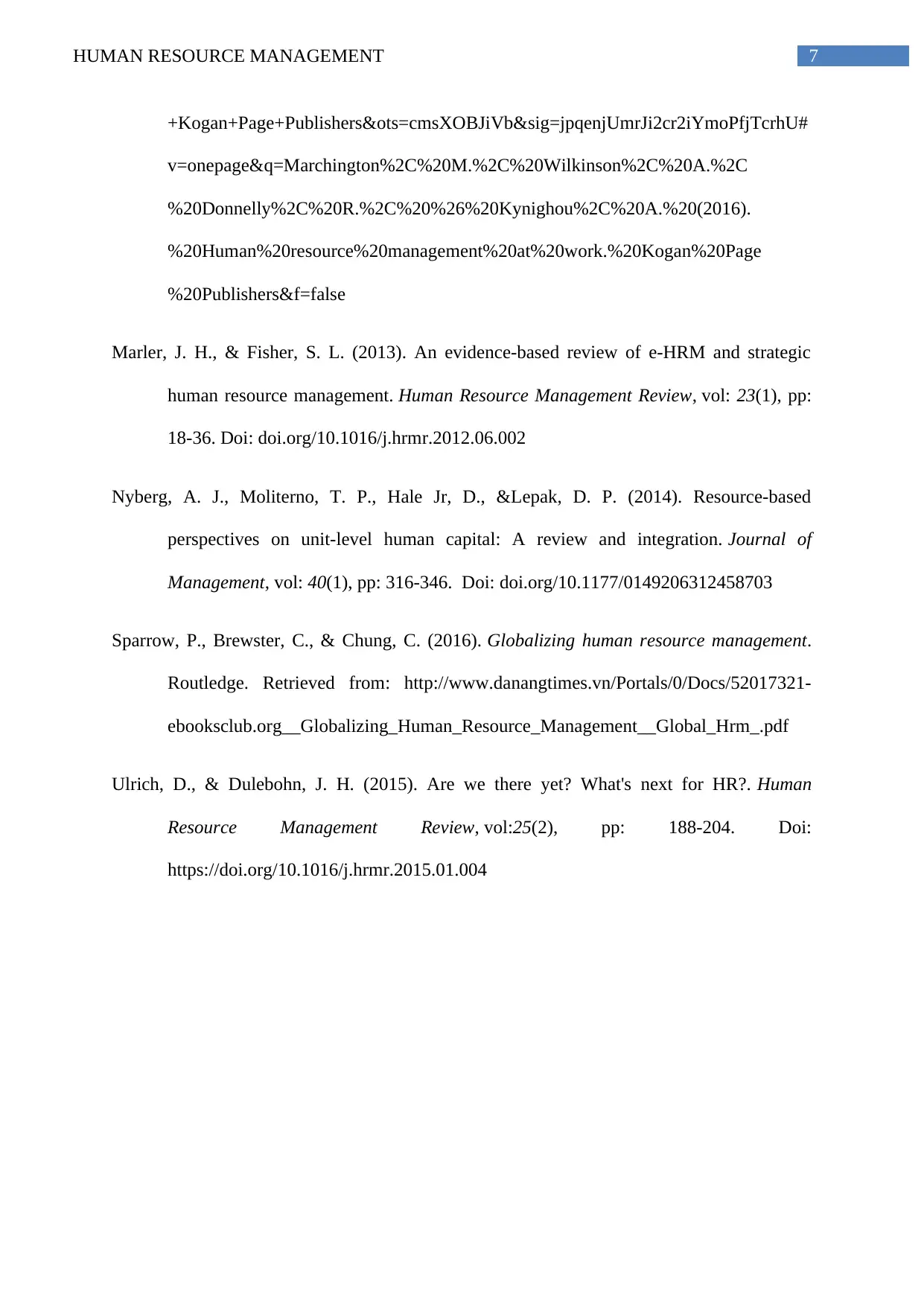
7HUMAN RESOURCE MANAGEMENT
+Kogan+Page+Publishers&ots=cmsXOBJiVb&sig=jpqenjUmrJi2cr2iYmoPfjTcrhU#
v=onepage&q=Marchington%2C%20M.%2C%20Wilkinson%2C%20A.%2C
%20Donnelly%2C%20R.%2C%20%26%20Kynighou%2C%20A.%20(2016).
%20Human%20resource%20management%20at%20work.%20Kogan%20Page
%20Publishers&f=false
Marler, J. H., & Fisher, S. L. (2013). An evidence-based review of e-HRM and strategic
human resource management. Human Resource Management Review, vol: 23(1), pp:
18-36. Doi: doi.org/10.1016/j.hrmr.2012.06.002
Nyberg, A. J., Moliterno, T. P., Hale Jr, D., &Lepak, D. P. (2014). Resource-based
perspectives on unit-level human capital: A review and integration. Journal of
Management, vol: 40(1), pp: 316-346. Doi: doi.org/10.1177/0149206312458703
Sparrow, P., Brewster, C., & Chung, C. (2016). Globalizing human resource management.
Routledge. Retrieved from: http://www.danangtimes.vn/Portals/0/Docs/52017321-
ebooksclub.org__Globalizing_Human_Resource_Management__Global_Hrm_.pdf
Ulrich, D., & Dulebohn, J. H. (2015). Are we there yet? What's next for HR?. Human
Resource Management Review, vol:25(2), pp: 188-204. Doi:
https://doi.org/10.1016/j.hrmr.2015.01.004
+Kogan+Page+Publishers&ots=cmsXOBJiVb&sig=jpqenjUmrJi2cr2iYmoPfjTcrhU#
v=onepage&q=Marchington%2C%20M.%2C%20Wilkinson%2C%20A.%2C
%20Donnelly%2C%20R.%2C%20%26%20Kynighou%2C%20A.%20(2016).
%20Human%20resource%20management%20at%20work.%20Kogan%20Page
%20Publishers&f=false
Marler, J. H., & Fisher, S. L. (2013). An evidence-based review of e-HRM and strategic
human resource management. Human Resource Management Review, vol: 23(1), pp:
18-36. Doi: doi.org/10.1016/j.hrmr.2012.06.002
Nyberg, A. J., Moliterno, T. P., Hale Jr, D., &Lepak, D. P. (2014). Resource-based
perspectives on unit-level human capital: A review and integration. Journal of
Management, vol: 40(1), pp: 316-346. Doi: doi.org/10.1177/0149206312458703
Sparrow, P., Brewster, C., & Chung, C. (2016). Globalizing human resource management.
Routledge. Retrieved from: http://www.danangtimes.vn/Portals/0/Docs/52017321-
ebooksclub.org__Globalizing_Human_Resource_Management__Global_Hrm_.pdf
Ulrich, D., & Dulebohn, J. H. (2015). Are we there yet? What's next for HR?. Human
Resource Management Review, vol:25(2), pp: 188-204. Doi:
https://doi.org/10.1016/j.hrmr.2015.01.004
1 out of 8
Related Documents
Your All-in-One AI-Powered Toolkit for Academic Success.
+13062052269
info@desklib.com
Available 24*7 on WhatsApp / Email
![[object Object]](/_next/static/media/star-bottom.7253800d.svg)
Unlock your academic potential
© 2024 | Zucol Services PVT LTD | All rights reserved.





